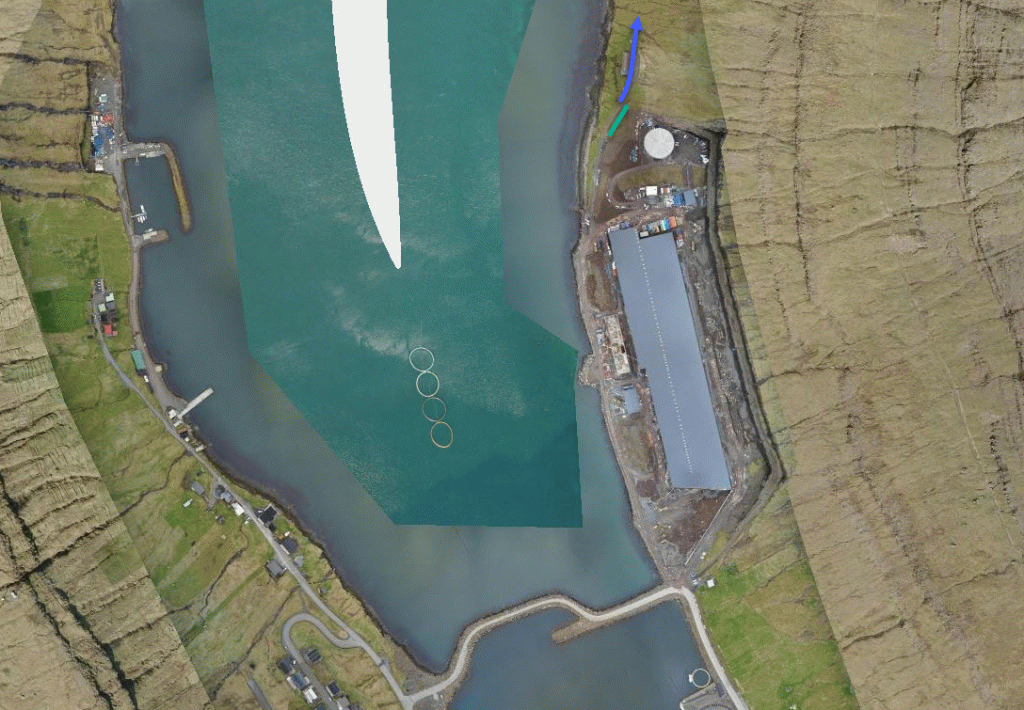Múli - Skálatoftir - Strond

Start in the magical village of Múli, north of Múlan, and hike between mighty mountains and across steep and beautiful paths to the ruined village of Skálatoftir. This trip is not recommended for those who have a fear of heights and must be done during periods of dry weather in the summer.
The route starts in the ancient village of Múli, which lies northward on the eastern side of the island of Borðoy. It is beautiful and peaceful arriving at Múli, even a bit peculiar. Guttorm í Múla is said to have a reputation that exceeded him—he was the most famous wizard in the Faroe Islands. This is probably why this place feels magical. No one lives there.
You will walk through the village on the northern side of the grassy terrain, where you will see some bushes. At about 100-meters further north, there is a fence that leads to the stone gate. You will walk up north of the fence, through the stone gate and then 30-meters further north to the corner of the fence, which lies on a flat surface in Hagabrúgv. From there, you walk north along the flat plains towards a sheep bolus 200-meters north. The path will not be visible during the start of your hike, but once you reach the sheep bolus and corn storage soon after, the track is visible. Before you know it, you are walking on steep terrain on the north side; notice that the path splits twice, and you must choose the upper trail both times.
Whilst you walk westward, the island of Kunoy will come into view. At about a 100-meter altitude, you will follow the village path around Múli. After making a round trip circling Múli, you start to walk southward. Here above Fuglatúvuna, you arrive at the steepest point of the route. During good summer days, this route is good to walk for people who are not afraid of heights. However, it is a different story during the winter as winter weather combined with the ocean directly beneath can easily cause unease.
On the path south of Ørmansdal, you walk through Múlagjógv and several deep gullies where the view down the rock ledges is excellent. From Ørmansdal and southward, it is not steep.
Ásagjógv is approximately kilometres south of Ørmansdal. This is where boats could set up in case of any route issues or bad weather. Here the boats could be dragged up onto the sand in the gorge; however, the boats could not be dragged out of the gorge, and the fishermen would sometimes sleep there. In later years this did become possible with the help of Heina-Jógvan, who also worked on the path to Árnafjarð. Today there is only a badly worn and rusty staple left, so walking there is not recommended.
Once arriving into vision, just south of Ásugjógv is Skálatoftir, with green cultivated fields and the ruined house remains. As you come nearer, it is easy to imagine how it was to live here as a community. Skálatoftir has a collection of only six houses, one of which is kept south of the stone gate. In 1880, 23 people lived in four houses, which is probably the highest number of people to have lived in Skálatoftir.
Three of these houses were built together like a connecting terrace; the set-up of these houses was Kongsstovan and Innistovan on each end, and between these two Roykstovan.
Up from the house furthest north, you walk down some steps to the landing called Kleivina, where boathouse foundations stand. It is interesting to consider that these steps are still decent to walk on even though they are overgrown with grass.
You walk up towards the house and from here back home through the grassy path. You continue along the village path once you arrive back through the stone gate; the first stretch is paved. There is much to see on the other side of the fjord, including some of the highest mountains in the Faroe Islands and Skarðsgjógv, the largest Faroese gorge. Before you know it, you have arrived south of Strond by the embarkment around Haraldssund.
Múli - Skálatoftir - Strond
There is a parking area in Múli—cite the green line. From the parking area, you walk a good 200-meters north through the small village until you reach a grassy road with bushes close by. From that road, you walk 100-meters further north to a fence which leads you to the stone gate 80-meters above. You then walk north of the fence upwards and out through the stone gate. From the stone gate, you walk 30-meters further north to the corner of the gate, which stands on flat terrain in Hagabrúgv. You walk north around the mountain along the village path—cite blue arrows.
Strond - Skálatoftir - Múli
SSL Bygdaleiðir, route 500/504 Klaksvík – Kunoy
https://www.ssl.fo/fo/ferdaaetlan/bygdaleidir/500-504-klaksvik-kunoy/
Parking in Strond, north of the embankment around Haraldssund:
By the enclosed area embarkment around Haraldssund, you will continue north towards the sea, north of Bakkafrost’s building, where you arrive at a road's end by a sheep’s house on the north side. You can park your car near the side of the road so that other cars can pass—cite the green line. From there, you will walk through a large gate facing north of the sheep house and then further through the gate north past the sheep house–cite blue arrows.
Múli - Skálatoftir - Strond
Strond - Skálatoftir - Múli
Facts
Duration
distance
Peak
Elevation

















